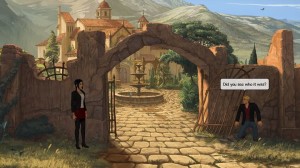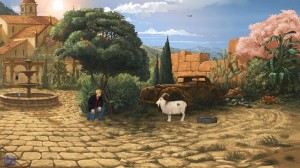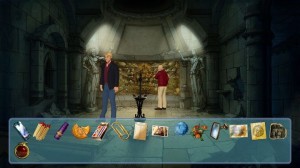Liverpool Sound and Vision Rating: 9.5 out of 10
Broken Sword 5: The Serpent’s Curse – Episode 2 is a point and click adventure game available for download from the PlayStation Store for the PS Vita. Episode 2 is the conclusion of Broken Sword 5: The Serpent’s Curse which continues the undeniable legacy of the Broken Sword saga since its timeless inception on the original PlayStation in 1996.
Broken Sword: The Shadow of the Templars introduced players to a new era of the point and click adventure on games consoles featuring the central character of the series, George Stobbart, and his investigations into all manner of criminal behaviour, which is offset by his own trademark humour and sarcasm. The Broken Sword series has spawned five games and remakes of the first two with each being a commercial and critical success with the series having won a number of awards and many award nominations. From Broken Sword: The Shadow of the Templars winning best adventure from Generation 4 and best quest from Quest magazine in 1997, to Broken Sword: The Sleeping Dragon winning the best adventure game of 2003 from Just Adventure and earning nominations in best design, best P.C. game and best adventure game from the British Academy Video Games Awards in 2003, as well as a nomination for excellence in writing from the Game Developers Choice Awards in 2004, all of which have only further cemented Broken Sword’s legacy in the point and click adventure genre.
The story follows directly on from the events of the first episode with George Stobbart and Nico Collard continuing their search for the truth surrounding the mysterious painting La Maledicco which was also at the centre of the story from the first episode, while George and Nico meet old friends and find more surprising revelations along the way.
There is an optional tutorial which is the recommended starting place as it allows players to learn how to navigate the game before venturing into the investigation that will be encountered in the story of the single player campaign. The tutorial will teach how to pick-up objects and use them to interact with the surroundings and characters throughout the game, alongside such abilities as observing objects and combining two items together.
The dialogue provides a lot of humour particularly from the lead character George Stobbart in a story and script written by the creator, writer and director of the Broken Sword series Charles Cecil. There is a scene in which George has déjà vu regarding a bad experience when he bumps into a goat towards the start of the second episode as goats tend to not like him. There are humorous and sarcastic comments throughout the dialogue that will always provide some laughs, which is a really positive design choice.
The design is amazing as all of the characters have their own unique looks, styles, mannerisms and voices that clearly differentiate one from another. George Stobbart is an excellent lead character with his humour and sarcasm and Nico Collard is just as good as a helpful investigative journalist with her charm and intelligence, alongside an entire supporting cast of brilliant characters that each standout from one another, regardless of if they are the good guys, bad guys or just simply indifferent.
The environment design is just as good as the character design as they merge together to create many amazing scenes played out across some equally luxurious locations, such as Catalonia along the foothills of the Pyrenees with many great background details allowing the surroundings to look as picturesque as you would expect in real life.
The puzzles are usually all connected in some way, which is a positive design choice as it means that an entire set of posers are relevant to each other and important to the progression through the story which makes them feel much more rewarding after being solved and provides more of a purpose to the puzzles, rather than just being a single randomly placed standalone brainteaser. A great example of this comes in the from of a situation that the player will find themselves in early on in the second episode as cover has to be maintained to prevent George and Nico from being shot by a gunman when the player arrives at their destination in Catalonia, therefore players have to provide a distraction in order for the gunman to be shooting at something else instead of George.
The inventory allows player to collect items that are important to the investigation and use them to progress in the appropriate direction by assessing the properties or using items to interact with the surrounding environments or perhaps taking items from the inventory to gain knowledge from another character that may be holding out on vital information.
The controls are well mapped to the Vita, especially considering that the control scheme is almost entirely centred upon the touch screen as it was in the first episode, although there are some face buttons that are used within the control scheme including pressing triangle to produce and close the contents of the inventory; holding R and swiping the rear touch pad to pan from left to right and vice versa in locations that are wider or larger than the touch screen; pressing X to perform primary actions for active hotspots and skip dialogue; pressing square to examine the active hotspots. As players explore the environments around them, they will interact with objects by tapping the touch screen in the area of the object and tapping again to further observe the object. Players can talk to people by tapping on the character and tapping on the conversation icon, followed by tapping on the appropriate icon that best represents the conversation needed at that given time. Players can also explore their inventory by tapping on the bag that represents the inventory icon to the bottom left of the touch screen, which can be assessed by tapping on them or using them to interact with the surroundings by dragging the item onto an object or person. Tapping the inventory icon to the bottom left of the touch screen will also produce a menu along the top left that allows players to pause the game; ask for hints when finding a puzzle rather difficult to overcome and save or load the game at any given time just by tapping on the appropriate icon.
The graphics look just as good as the first episode with a stylised cel-shaded approach, while the characters, surrounding environments and objects are all very bright and colourful with plenty of detail that collectively works extremely well and makes their world come alive, which is further complemented by excellent fluent animations for all of the character models.
The presentation of the game is solid with a great purely touch screen based user interface across various menus such as the main menu, options and various gameplay menus, although that means there is no support for navigation via the left and right analogue sticks, directional pad, face buttons and rear touch pad, which is a bit surprising considering they are mostly the usual method of navigating a game. The background of the main menu screen looks as though it consists of a piece of architecture that most probably ties in with the painting that is at the heart of the storyline.
The voice-over artists provide each character with unique personalities via exceptional performances to supply the standout area of audio. There is some returning voice-over talent from previous Broken Sword games and some new voices that form a very experienced cast. Rolf Saxon returns as lead voice-over artist for Broken Sword’s series protagonist George Stobbart. Rolf Saxon has voiced George Stobbart in every Broken Sword game since the original in 1996 and has plenty of experience in film and television productions, such as being in Mission Impossible, alongside roles in the James Bond film Tomorrow Never Dies, Saving Private Ryan as Lieutenant Briggs and Entrapment. Emma Tate who voices Nico Collard, Maria, a young Tiago Marques and Sofia has a massive amount of experience in voice-overs having had roles in television including Captain Scarlet, The Jungle Book, Angelina Ballerina and more besides. She has had extensive roles in videogames such as the Wallace and Gromit episodic season, Rogue Trooper, Shinobido, Dragon Age II, Dragon Age: Inquisition and LEGO: The Hobbit, amongst others. Toby Longworth voices Marques having voiced Senator Lott Dodd and Gragra in Star Wars: Episode I – The Phantom Menace as well as videogames such as Tropico 5, Sacred 3, Risen 3: Titan Lords and more besides. The sound effects breathe some life into the world as players will hear characters walking, interacting with objects and birds chirping, while the music is an appropriate classical soundtrack composed by Barrington Pheloung.
The trophy list includes 14 trophies with 11 bronze, 2 silver and 1 gold trophy. Broken Sword 5: Episode 2’s trophy list is essentially easy as all but 4 of them are story related, therefore 10 of the 14 trophies will be naturally earned as progression is made through the storyline with the only difficulty coming from the 4 missable trophies that are relatively easy if you know what to do and when to do it. The story related trophies include the Outwitted the Goat bronze trophy for outwitting the irritated goat, while the missable trophies include the I Call It The Dreamatorium bronze trophy for winning a battle in your own mind; the Local Call silver trophy for chilling out to Radio Yorkshire; the Super-Charged Potpourri Easter Egg bronze trophy for nearly making Pearl faint with heavenly delight; and the Best Buddies silver trophy for chatting with and feeding the goat a variety of items. It is estimated that depending upon skill and a good trophy guide to provide some helpful tips to find the hidden objects for the 4 missable trophies that it would take anywhere from 3 to 5 hours to 100% the trophy list.
There are no difficulty levels, but there are plenty of puzzles to solve, resulting in the difficulty level being the equivalent to how hard players find the puzzles to overcome. There will be a few puzzles that may potentially trip players up but with some logic and process of elimination, figuring them out should happen sooner rather than later for the majority of the puzzles.
There are no online multiplayer features or online leaderboards, although the exclusion of online multiplayer is understandable as the focus of the game is to solve the mystery being gradually untangled. Online co-operative multiplayer may have possibly worked for two players to team up to figure out the puzzles as two heads are better than one sometimes, but the lack of online multiplayer features does not detract from the experience as players would not anticipate such a feature from a story driven point and click focused game in a genre that is usually solely single player. However, online leaderboards could have worked well by providing a competitive challenge in regards to how quick each player had solved each of the puzzles and completed the entire episode.
The replayability of Broken Sword 5: Episode 2 stems from naturally wanting to play through the game again due to how much fun will be had exploring the possibilities of the humorous dialogue and overcoming all of the puzzles again, although this episode is noticeably shorter than the first episode, but still provides a great conclusion to an amazing story.
Overall, the second episode of Broken Sword 5: The Serpent’s Curse does exactly what it promised to offer with an entertaining point and click adventure unlike any other with a cast of hilarious characters and plenty of intriguing intertwining puzzles to solve. If you are a fan of point and click adventure and puzzle games, then it should certainly be added to your absolute must buy list, especially for how well it concludes the story and adventure.
Jason Bonnar
Analysis
- Title: Broken Sword 5: The Serpent’s Curse – Episode 2
- Developer: Revolution Software
- Publisher: Revolution Software
- System: PS Vita
- Format: PSN Download
- Cross-Buy: No
- Cross-Play: No
- Players: 1
- Memory Card Space Required: 1.1GB


